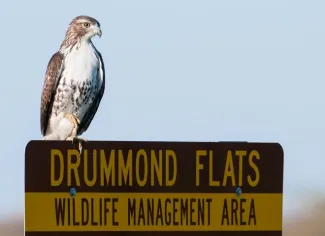Winter is a great time for bundling up, exploring Outdoor Oklahoma, and building bird-watching skills! Raptors, or birds of prey, can be found hunting across the state and are a great group of birds to test your bird-watching wings. The term "raptor" can include hawks, eagles, owls, falcons, and sometimes even vultures. They typically have hooked beaks and sharp talons and hunt for meat.
Peering at these birds of prey through binoculars may feel a bit hawkward at first, but you'll have a hoot in no time!

Red-tailed hawk.
Watching the Watchers
Most raptors watch for prey from a perch and will tolerate curious birders from a distance. Because the birds can fly away at any time, we recommend cataloging as many details as possible, as quickly as possible. If a bird is perched, study size, coloration, shape of the head and bill, and the presence or absence of leg feathers. If the bird is in flight, focus on the wing shape and any contrasting coloration. Then use a field guide to help narrow the options.
The entire state of Oklahoma, with its many diverse habitats, can be a raptor-watching hotspot. Bald eagles flock to the state each winter to fish in open waters and can be seen along many rivers and lakes. Hawks and falcons can often be spotted perched along tree lines, power poles, or fencerows. And owls can be heard and seen across the state. Though rural areas tend to offer more raptor-watching locations, urban parks and established neighborhoods can also be great raptor-watching locations.
Binge-able Birding
Raptors can be found nearly 24/7/365. Most are active during the day but owls swoop in for the night. Our raptor community also shifts seasonally, with migrants joining our resident species either in spring or fall, providing a diverse birding experience.
Regardless of the time or season you watch birds, you can always share photos and sighting details with the Wildlife Department, or on free platforms like eBird or iNaturalist.
Safety First
Birding by car is a convenient way to watch raptors, especially on cold winter days. But don't watch birds more than you watch the road! Stay alert, ask your birding partner to watch for hazards, and find a safe pull off before you ... well ... watch the bird like a hawk.